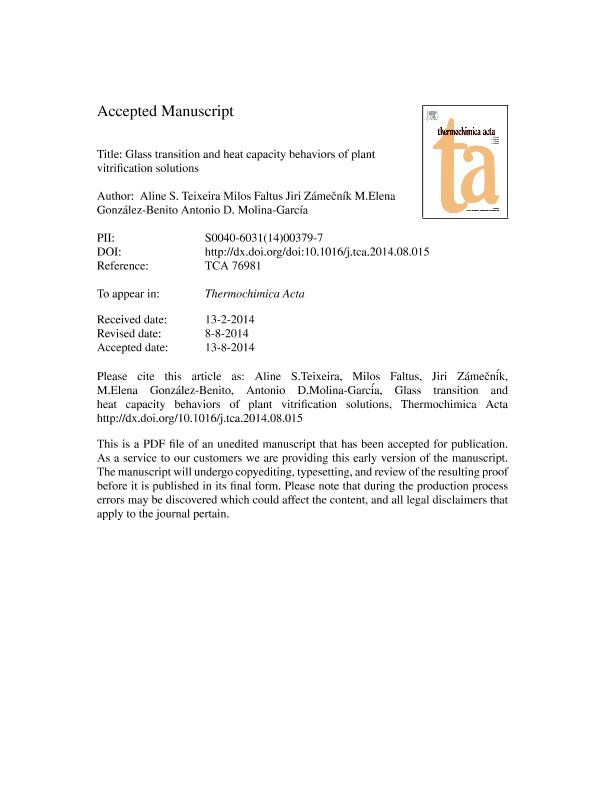Mostrar el registro sencillo del ítem
dc.contributor.author
Schneider Teixeira, Aline

dc.contributor.author
Faltus, Milos
dc.contributor.author
Zámečníkc, JirI
dc.contributor.author
Gonzalez Benito, Maria Elena
dc.contributor.author
Molina García, Antonio D.
dc.date.available
2016-12-28T19:01:22Z
dc.date.issued
2014-10
dc.identifier.citation
Schneider Teixeira, Aline; Faltus, Milos; Zámečníkc, JirI; Gonzalez Benito, Maria Elena ; Molina García, Antonio D. ; Glass transition and heat capacitybehaviors of plant vitrification solutions; Elsevier Science; Thermochimica Acta; 593; 10-2014; 43–49
dc.identifier.issn
0040-6031
dc.identifier.uri
http://hdl.handle.net/11336/10550
dc.description.abstract
Differential scanning calorimetry (DSC) was employed to investigate the vitrification and annealing behaviors of the most commonly used plant vitrification solutions (PVS). These solutions are employed to protect plant tissues towards ice formation and freeze injury, and help to the vitrification of these tissues, by globally reducing the intracellular fluids mobility. Glass transition temperatures (Tg) and heat capacity increments (∆Cp) were determined for five solutions PVS1, PVS2, PVS2 mod, PVS3 and PVS3 mod, with different composition, and a range of cooling and warming rates was employed. Glass transitions showed clear and consistent temperature differences within vitrification solutions, which could be related to composition and water content. Roughly, two sets of TG values were obtained, those for PVS1 and 2, at -112 ºC and -114 ºC, respectively, and those for PSV3, at -90 ºC. The observed Tg and ∆Cp, unexpectedly, did not significantly change within a wide range of cooling rates (from 5 ºC min-1 to liquid nitrogen quenching) and warming rates (from 5 to 20 ºC). Garlic shoot tips cryopreserved after the droplet method produced a similar result to that of the vitrification solutions employed. After quench cooling to temperatures below Tg, repeated excursions to higher temperatures were made and the cooling and warming Tg were recorded. These treatments had little or no effect over the PVS solutions Tg, which remained practically constant. A direct practical consequence is that the plant vitrification solutions glass transition temperature does not significantly change with cryopreservation methods based on either direct plunging of samples into liquid nitrogen or employing closed cryovials.
dc.format
application/pdf
dc.language.iso
eng
dc.publisher
Elsevier Science

dc.rights
info:eu-repo/semantics/openAccess
dc.rights.uri
https://creativecommons.org/licenses/by-nc-sa/2.5/ar/
dc.subject
Dsc
dc.subject
Plant Vitrification Solution
dc.subject
Tg
dc.subject
∆Cp
dc.subject
Cryopreservation
dc.subject.classification
Biofísica

dc.subject.classification
Ciencias Biológicas

dc.subject.classification
CIENCIAS NATURALES Y EXACTAS

dc.title
Glass transition and heat capacitybehaviors of plant vitrification solutions
dc.type
info:eu-repo/semantics/article
dc.type
info:ar-repo/semantics/artículo
dc.type
info:eu-repo/semantics/publishedVersion
dc.date.updated
2016-12-12T14:11:55Z
dc.journal.volume
593
dc.journal.pagination
43–49
dc.journal.pais
Países Bajos

dc.journal.ciudad
Amsterdam
dc.description.fil
Fil: Schneider Teixeira, Aline. Consejo Nacional de Investigaciones Científicas y Técnicas. Centro Científico Tecnológico la Plata. Centro de Investigaciones En Criotecnología de Alimentos (i); Argentina. Universidad Nacional de La Plata; Argentina. Consejo Superior de Investigaciones Científicas. Instituto de Ciencia y Tecnologia de Alimentos y Nutrición; España
dc.description.fil
Fil: Faltus, Milos. Crop Research Institute; República Checa
dc.description.fil
Fil: Zámečníkc, JirI. Crop Research Institute; República Checa
dc.description.fil
Fil: Gonzalez Benito, Maria Elena . Universidad Politécnica de Madrid. Escuela Técnica Superior de Ingenieros Agrónomos de Madrid; España
dc.description.fil
Fil: Molina García, Antonio D. . Consejo Superior de Investigaciones Científicas. Instituto de Ciencia y Tecnologia de Alimentos y Nutrición; España
dc.journal.title
Thermochimica Acta

dc.relation.alternativeid
info:eu-repo/semantics/altIdentifier/doi/http://dx.doi.org/doi:10.1016/j.tca.2014.08.015
Archivos asociados
